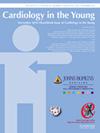加巴喷丁作为治疗儿童上腔肺连接手术后烦躁的新型辅助药物
IF 0.9
4区 医学
Q4 CARDIAC & CARDIOVASCULAR SYSTEMS
引用次数: 0
摘要
目的:描述我院在标签外使用加巴喷丁治疗腔肺上连接手术后的烦躁及其对后续阿片类药物和苯二氮卓类药物需求的影响。方法:这是一项单中心回顾性队列研究,包括 2011 年至 2019 年期间接受腔肺上连接手术的婴儿。结果74名受试者(74/323,22.9%)在观察期间使用了加巴喷丁,起始剂量中位数(IQR)为5.7(3.3,15.0)毫克/千克/天,最大剂量为10.7(5.5,23.4)毫克/千克/天。与 2011-14 年接受手术的婴儿相比,2015-19 年接受手术的婴儿更有可能接受加巴喷丁治疗(p < 0.0001)。接受加巴喷丁治疗的婴儿手术时年龄更小(137 天对 146 天,p = 0.007),胸管插管时间更长(1.8 天对 0.9 天,p <0.001),术后重症监护时间(5.8 天对 3.1 天,p <0.0001)和住院时间(11.5 天对 7.0 天,p <0.0001)更长。在多变量分析中,手术年份是唯一与加巴喷丁用药相关的诱发因素。在调整后的线性回归中,术后第0-4天服用加巴喷丁的婴儿(n = 64)与未服用加巴喷丁的婴儿相比,术后3天苯二氮卓类药物暴露量减少(-0.29 mg/kg, 95% CI -0.52 -0.06,p = 0.01),而阿片类药物暴露量则无差异(p = 0.59)。结论在研究期间,加巴喷丁的使用频率越来越高。使用加巴喷丁可适度减少苯二氮卓类药物的需求量,但阿片类药物的需求量并未减少。随机对照试验可以更好地评估加巴喷丁对先天性心脏病患儿术后的益处。本文章由计算机程序翻译,如有差异,请以英文原文为准。
Gabapentin as a novel adjunct for postoperative irritability after superior cavopulmonary connection operation in children
Objectives: Describing our institution’s off-label use of gabapentin to treat irritability after superior cavopulmonary connection surgery and its impact on subsequent opiate and benzodiazepine requirements. Methods: This is a single-center retrospective cohort study including infants who underwent superior cavopulmonary connection operation between 2011 and 2019. Results: Gabapentin was administered in 74 subjects (74/323, 22.9%) during the observation period, with a median (IQR) starting dose of 5.7 (3.3, 15.0) mg/kg/day and a maximum dose of 10.7 (5.5, 23.4) mg/kg/day. Infants who underwent surgery in 2015–19 were more likely to receive gabapentin compared with those who underwent surgery in 2011–14 (p < 0.0001). Infants prescribed gabapentin were younger at surgery (137 versus 146 days, p = 0.007) and had longer chest tube durations (1.8 versus 0.9 days, p < 0.001), as well as longer postoperative intensive care (5.8 versus 3.1 days, p < 0.0001) and hospital (11.5 versus 7.0 days, p < 0.0001) lengths of stays. The year of surgery was the only predisposing factor associated with gabapentin administration in multivariate analysis. In adjusted linear regression, infants prescribed gabapentin on postoperative day 0–4 (n = 64) had reduced benzodiazepine exposure in the following 3 days (−0.29 mg/kg, 95% CI −0.52 – −0.06, p = 0.01) compared with those not prescribed gabapentin, while no difference was seen in opioid exposure (p = 0.59). Conclusions: Gabapentin was used with increasing frequency during the study period. There was a modest reduction in benzodiazepine requirements associated with gabapentin administration and no reduction in opioid requirements. A randomised controlled trial could better assess gabapentin’s benefits postoperatively in children with congenital heart disease.
求助全文
通过发布文献求助,成功后即可免费获取论文全文。
去求助
来源期刊

Cardiology in the Young
医学-小儿科
CiteScore
1.70
自引率
10.00%
发文量
715
审稿时长
4-8 weeks
期刊介绍:
Cardiology in the Young is devoted to cardiovascular issues affecting the young, and the older patient suffering the sequels of congenital heart disease, or other cardiac diseases acquired in childhood. The journal serves the interests of all professionals concerned with these topics. By design, the journal is international and multidisciplinary in its approach, and members of the editorial board take an active role in the its mission, helping to make it the essential journal in paediatric cardiology. All aspects of paediatric cardiology are covered within the journal. The content includes original articles, brief reports, editorials, reviews, and papers devoted to continuing professional development.
 求助内容:
求助内容: 应助结果提醒方式:
应助结果提醒方式:


